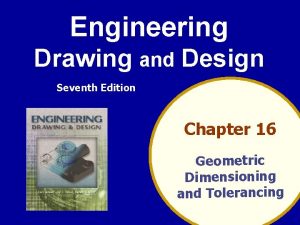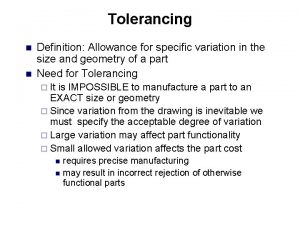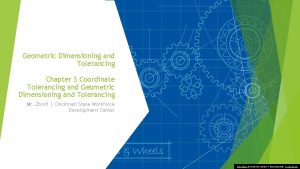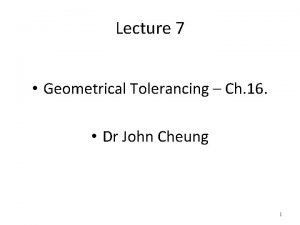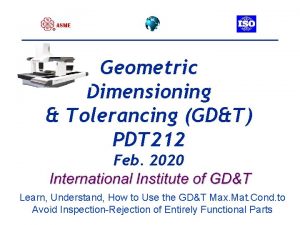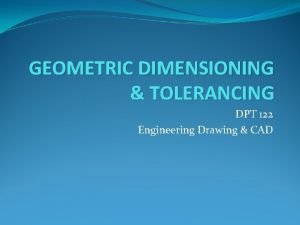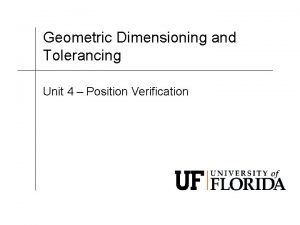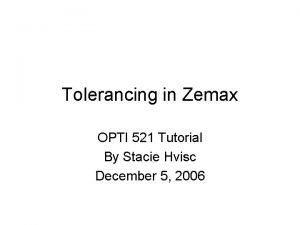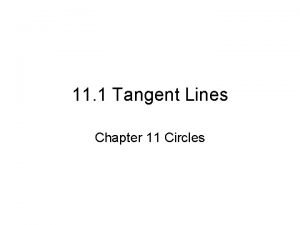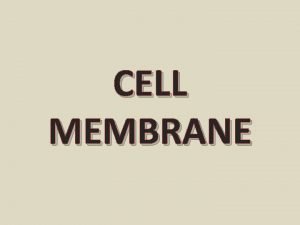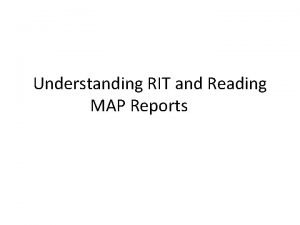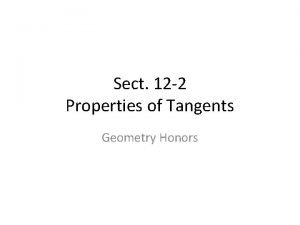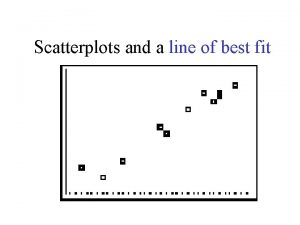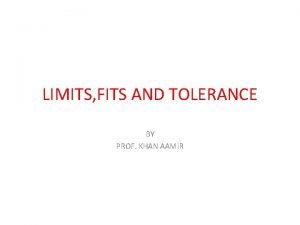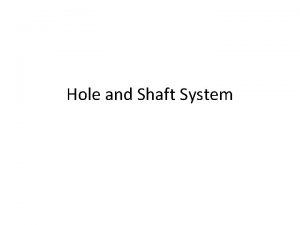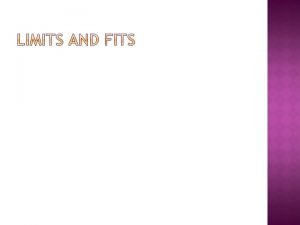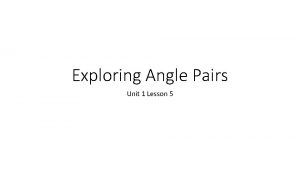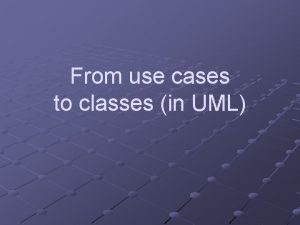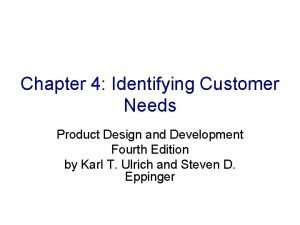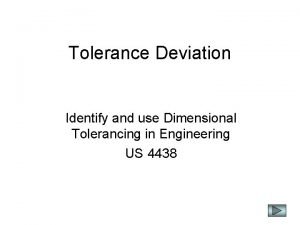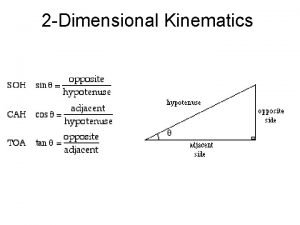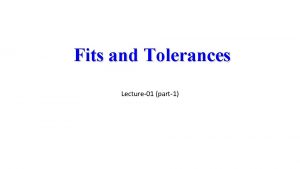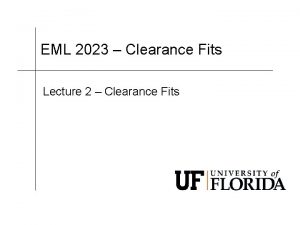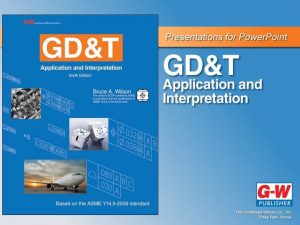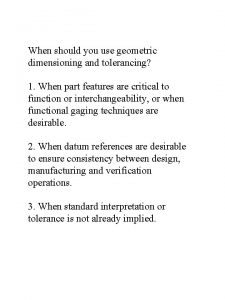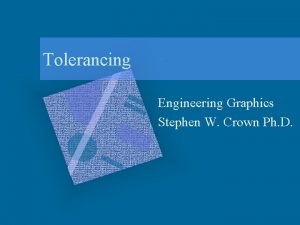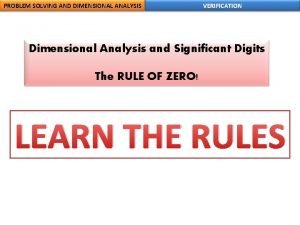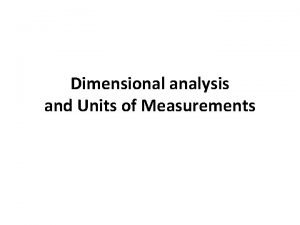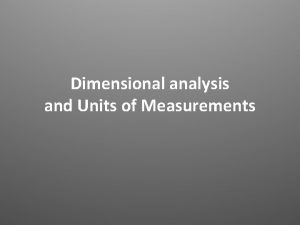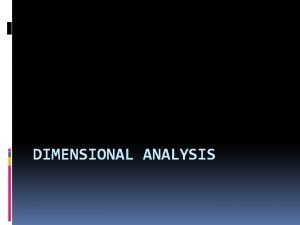Fits Identify and use Dimensional Tolerancing in Engineering































- Slides: 31

Fits Identify and use Dimensional Tolerancing in Engineering US 4438 Giles Lancaster Marlborough Boys College

Contents • • • Fits Clearance Fit Examples Types Interference Fit Examples Types Transition Fit Examples Types Descriptions translated to numbers Questions – One – Two

Fits • When two parts of a machine or assembly are put together they do so with varying degrees of slackness or tightness • The degree of slackness or tightness is called the fit of the parts • There are three classes of fit

Clearance Fit • When there is easy movement after two parts are assembled it is a clearance fit – They slide together and apart with clearance Hole Shaft

Examples • Clearance Fit – Door in a door frame (if its not sticking) – Fan blade in its housing – A washer on a bolt – Big end bearing on a crank shaft – All shafts that rotate in plain bearings

Loose Running Free Running Close Running Sliding Fit Locational Clearance Assembled Parts • • • Decreasing Clearance Between Types of Clearance Fit

Interference Fit • When there is no movement after two parts are assembled it is an interference fit – They have to be forced together and stay locked together unless force is applied Hole Force Shaft

Examples • Interference Fit – A nail hammered into a piece of wood – The steel band on a wine barrel – The ring gear on the flywheel of your car

– (Light Press) • Medium Drive Fit – (Press Fit) • Force Fit – (Heavy Press Fit or Shrink Fit Increasing Force To Assemble • Location Interference Fit Increasing Grip Between Assembled Parts Types of Interference Fits

Transition Fit • When a random selection of assembled parts results in some clearance fits and some interference fits it is a transition fit. The class between clearance and interference Hole Shaft Small Force A pure transition fit occurs when the shaft and hole are the same actual size

Examples • Transition Fit – Location pins on a jig – Gudgen pins connecting pistons to con rods – Door hinge pin

• Easy Key • Tight keying Decreasing movement Between Assembled Parts Increasing Force To Assemble Types of Transition Fit

Qualitative to Quantitative Words to Numbers • Descriptions of fits are not much use to engineers • There actual clearances and interferences specified in. 0001 of a mm for each type of fit. These ensure that the assembled parts function as intended • Accuracy of machining is required

Question 1 Answer by clicking on the correct answer • What type of fit is indicated in each case Hole Shaft A: Clearance Transition Interference Hole C: Hole B: Shaft Clearance Transition Interference Question 2

Question 2 Answer by clicking on the correct answer • What type of fit is indicated in each case i: Shaft 25. 00 Hole 25. 04 Clearance Transition iv: Shaft 23. 00 Hole 22. 95 Interference Clearance ii: Shaft 76. 02 Hole 76. 08 Transition Interference Clearance iii: Shaft 25. 00 Hole 24. 94 Transition Interference Clearance Transition Interference v: Shaft 30. 00 Hole 30. 00 Clearance Transition Interference Clearance vi: Shaft 56. 08 Hole 56. 04 Transition Interference

Giles Lancaster Marlborough Boys College 5 Stephenson Street Blenheim 03 578 0119 Ext 209 gilesl@mbc. school. nz

The Three Sizes • Nominal Size – A size without specific limits of accuracy • Basic Size – Is the size about which the limits are set – It is the same for the hole and shaft • Actual Size – The size of the hole or shaft as measured – Note the measuring equipment has limits of accuracy as well

Accuracy • Is how close the actual size is to basic size • The greater the accuracy the smaller the difference between the actual and basic size • The greater the accuracy required the greater the cost – – More time More expensive machining equipment More expensive measuring equipment Cost is asymptotic to accuracy

Classes are groupings of individual types or sub classes for example Classes of Transport Sub Classes Individual Vehicle Trucks Automobiles Buses Cars Light Trucks Up to 12 Seats Saloon 5 to 10 Ton Trucks 12 to 40 Seats Sports > than 10 Ton Trucks > Than 40 Seats Station Wagon Nissan Atlas Reg QF 123


No Try again • A clearance fit always allows movement after assembly and requires no force to assemble • A transition fit does not allow movement after assembly and requires only a small force to assemble • A interference fit does not allow movement after assembly and requires large forces to assemble

Loose Running Fit • For wide commercial tolerances, where ease of assembly is required • Using ISO tolerance grade numbers and fundamental deviation letters CAPITALS for the hole and lower case for the shaft • H 11/c 11

Free Running Fit • Useful for high running speeds, heavy radial loading and large temperature variations, where accuracy is not essential. • Using ISO tolerance grade numbers and fundamental deviation letters CAPITALS for the hole and lower case for the shaft • H 9/d 9

Close Running Fit • For moderate running speeds, moderate radial loading and accurate location. • Using ISO tolerance grade numbers and fundamental deviation letters CAPITALS for the hole and lower case for the shaft • H 8/f 7

Sliding Fit • Not intended to run freely but to move and turn freely and provide accurate location • Using ISO tolerance grade numbers and fundamental deviation letters CAPITALS for the hole and lower case for the shaft • H 7/g 6

Locational Clearance • Provides snug fit for locating stationary parts. Can be freely assembled and disassembled • Using ISO tolerance grade numbers and fundamental deviation letters CAPITALS for the hole and lower case for the shaft • H 7/h 6

Easy Key • Locational Transition fit for accurate location • Using ISO tolerance grade numbers and fundamental deviation letters CAPITALS for the hole and lower case for the shaft • H 7/k 6

Tight Key • Locational transition for very accurate location where greater force to assemble is permissible • Using ISO tolerance grade numbers and fundamental deviation letters CAPITALS for the hole and lower case for the shaft • H 7/n 6

Locational Interference • For parts requiring rigidity and alignment with extreme accuracy of location. Can be disassembled with moderate force. • Using ISO tolerance grade numbers and fundamental deviation letters CAPITALS for the hole and lower case for the shaft • H 7/p 6

Medium Drive Fit • For ordinary steel parts or shrink fits on light sections • Using ISO tolerance grade numbers and fundamental deviation letters, CAPITALS for the hole and lower case for the shaft • H 7/s 6

Force Fit • Suitable for parts that are highly stressed or for shrink fits where heavy pressing forces required are impractical • Using ISO tolerance grade numbers and fundamental deviation letters, CAPITALS for the hole and lower case for the shaft • H 7/u 6
 Geometric dimensioning and tolerancing
Geometric dimensioning and tolerancing A circular motion is one dimensional
A circular motion is one dimensional Allowance vs tolerance
Allowance vs tolerance What is coordinate tolerancing
What is coordinate tolerancing Geometric tolerance
Geometric tolerance Tolerancing
Tolerancing Feature control frame
Feature control frame Tolerancing
Tolerancing Tolerancing
Tolerancing Zemax demo download
Zemax demo download Limits fits and tolerances
Limits fits and tolerances Fits and tolerance شرح
Fits and tolerance شرح Hole basis fits
Hole basis fits Which fits best in the empty box above?
Which fits best in the empty box above? Strange fits of passion have i known
Strange fits of passion have i known Security that fits everywhere
Security that fits everywhere A bicycle chain fits tightly around two gears
A bicycle chain fits tightly around two gears Judicial restraint clipart
Judicial restraint clipart Practice 11-1 tangent lines
Practice 11-1 tangent lines Most common blood type in europe
Most common blood type in europe What precautions best fits this pictogram
What precautions best fits this pictogram One size fits all
One size fits all Focl in machine learning
Focl in machine learning A belt fits tightly around two pulleys
A belt fits tightly around two pulleys The equation y=12.21x+37.42 fits the scatter plot
The equation y=12.21x+37.42 fits the scatter plot Limit fit tolerance
Limit fit tolerance Hole basis system chart
Hole basis system chart Limts
Limts Exploring angle pairs
Exploring angle pairs How to identify classes from use cases
How to identify classes from use cases What are the methods ways to use to identify customer needs
What are the methods ways to use to identify customer needs Forward engineering and reverse engineering
Forward engineering and reverse engineering
